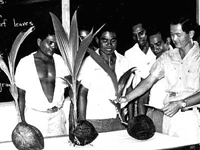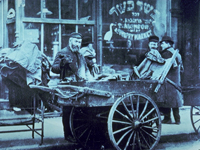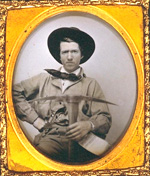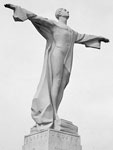The Carolina Room
Modern-day curators focus on reversible restoration techniques. Conservator Shelley Svoboda describes the renewal of the Carolina Room.
Modern-day curators focus on reversible restoration techniques. Conservator Shelley Svoboda describes the renewal of the Carolina Room.
As important as the cannon is the vehicle to carry it: a two-wheeled cart that transports, supports, and stores the weapon and its accoutrements. Wheelwright John Boag has the task of construction.
According to BackStory:
"To mark the rebirth of BackStory as a weekly program, the History Guys set out to explore the earliest stages of life in America. They begin with a few of the basic assumptions we have about birth in America today, and spend the hour exploring how those assumptions came into being. How is it that hospital doctors moved in on what had been midwife’s exclusive territory? Why did Puritans think their newborns were damned from the outset? When did courts start ruling that fetuses had legal rights? Why have generations of Americans resisted the notion of birthright citizenship?"

This website offers more than 50,000 slides and photographs that document the history of the American period in Micronesia from 1947 to 1988. The image collection can be browsed or the visitor can sample the types of images in the collection through 12 short animated image tours. The topics of the image tours give an idea of the variety of images available in the collection: parades, dancing, voting, agriculture, stone money, canoes, architecture, women, leaders, education and children, health and hospitals, and men. The only search capability on the site is a Google search of the photograph description files. Additional resources include a map of Oceania and a link to the Hawaii War Records Archive. This archive is a useful source of images for those researching, writing, or teaching the cultural history of the Pacific Islands.

A gateway and an archive of numerous articles on New York history, this site "focuses a particularly long lens on the early history of political and economic events, panics, riots and other related matters affecting or contributing to New York City's development and growth." Its main feature is the New York state and New York City directories. (The U.S. directory is currently unavailable.) The New York state directory offers more than 700 links and more than 60 articles organized under 21 topics that include the arts, cities and counties, ethnic groups, military, societies and associations, transportation, women and their professions, and worship.
The New York City directory offers more than 5,200 links and more than 700 articles organized under 58 topics that include architecture, the arts, business matters, city government, clubs and societies, crime and punishment, education, ethnic groups, 5th Avenue, Harlem, immigration, New York City panics, real estate, temperance and prohibition, and Wall Street. The visitor can search the entire site or each directory by keyword. This site is a good starting point for researching the history of New York. It should also be useful for literary scholars, writers, and historical societies.

This archive provides more than 81,000 images and 1,000 texts on the history and culture of California. Images may be searched by keyword or browsed according to six categories: history, nature, people, places, society, and technology. Topics include exploration, Native Americans, gold rushes, and California events.
Three collections of texts are also available. Japanese American Relocation Digital Archive furnishes 309 documents and 67 oral histories. Free Speech Movement: Student Protest, U.C. Berkeley, 19641965 provides 541 documents, including books, letters, press releases, oral histories, photographs, and trial transcripts.
UC Berkeley Regional Oral History Office offers full-text transcripts of 139 interviews organized into 14 topics including agriculture, arts, California government, society and family life, wine industry, disability rights, Earl Warren, Jewish community leaders, medicine (including AIDS), suffragists, and UC Black alumni.
Scholars in Action presents case studies that demonstrate how scholars interpret different kinds of historical evidence. This untitled daguerreotype of Niagara Falls was taken in 1853 by Platt Babbitt and reflects an era when the expansion of railroads and the rise of middle-class occupations enabled some Americans to enjoy leisure travel.
The daguerreotype process, the earliest form of photography, involved the painstaking manipulation of light, chemicals, and copper plates. Daguerreotypes were made public in 1839 and quickly became a popular medium in the United States for a growing middle class eager to document themselves and their surroundings. While daguerreotypes could not be mass produced, they often served as the basis for newspaper illustrations that reached large numbers of Americans.

April 15, 2012, marks the centennial of the sinking of the RMS Titanic, a disaster that still looms large in popular imagination. Why is the Titanic so well remembered? What sets it apart from the hundreds of disasters at sea that have happened before and after?
Use the centennial as a chance to ask your students how they know what they know about history. Do they know about the ship? Where did they learn about it? From a book or a movie? Your students can bring together the skills of historians and scientists to uncover their own answers about the disaster—from who was on the ship to why it sank to how the story of the Titanic fits into history and the present day.
Where to begin? We've gathered some ideas for places to start your search for resources:
James Cameron's film Titanic has helped keep the disaster in public memory. But does the film say more about 1997 than it does about 1912? Historian Steven Biel shares a critical look at Titanic in a film review reprinted from the Journal of American History.
From the Bowery Boys website:
"The discovery of radio changed the world, and New York City was often front and center for its creation and development as America's prime entertainment source during the 1930s and 40s. In this show, we take you on a 50-year journey, from Marconi's newsmaking tests aboard a yacht in New York Harbor to remarkable experiments atop the Empire State Building.
Two of the medium's great innovators grew up on the streets of New York, one a fearless inventor born in the neighborhood of Chelsea, the other an immigrant's son from the Lower East Side who grew up to run America's first radio broadcasting company (RCA). Another pioneer with a more complicated history made the first broadcasts that featured the human voice, the 'angelic' tones of a Swedish soprano heard by a wireless operator at the Brooklyn Navy Yard.
The second half of our show features the creation of the great radio networks and many local New York stations that are still around today. What indispensable station got its start as a department-store radio channel? What borough was touted in the very first radio advertisement? What former Ziegfeld Follies star strapped on a bonnet to become Baby Snooks?
Featuring tales of the Titanic, the rogue adventures of amateur operators, and a truly scary invasion from outer space!"

The United States Coast Guard, one of the five U.S. military branches, protects the environment and U.S. citizens, economic interests, and security in the world's oceans and bodies of inland water. Specific duties include rescue operations and maritime law.
The Coast Guard's home on the web is certainly not the easiest to navigate of the Armed Forces sites. However, it does contain a noteworthy amount of content which could be put to use in the classroom, particularly background information for teachers or for student reports.
Items worth your attention include a Coast Guard blog with posts on the organization's history; a list of Coast Guard historical events, organized by day of the year; overall and regional history overviews, most in the form of PowerPoint presentations or articles; and histories of Coast Guard assets, missions, and personnel, including women and minorities.
Primary sources are also available in abundance. These include oral histories divided by theme and military engagement, back issues of official magazines, a selection of documents dating from 1791 through the late 20th century, and galleries of historic photographs. The photographs can be compared to recent images and artworks located within the Coast Guard multimedia gallery. Of the magazines, the majority offer back issues from the 2000s. However, The Reservist offers issues dating as far back as the 1950s.
If you are looking specifically for children's activities, check out "Just for Kids (and Teachers!)", which offers coloring books, information on animal mascots adopted by various Coast Guard units, teacher's guides for lighthouse and Coast Guard history, and images of lighthouses. You may also want to peruse the suggested reading list for even more in depth preparation.
Another item worth your attention is a page devoted to U.S. revenue cutters during the War of 1812. On this page, you can find paintings, ship's plans, and illustrations of the cutters and their personnel; histories of individual cutters, Captain Frederick Lee, and prisoners of war; brief overviews of the role played by the cutters; and a bibliography to assist further research.
Finally, if you want to get the kids out of the classroom and you are in the Connecticut area, you could try the U.S. Coast Guard Museum. Not in New England? Try the artifact finder to pinpoint museums in your state with Coastie artifacts.